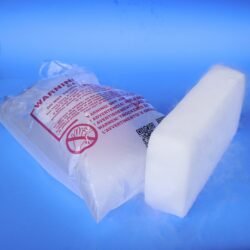Dry ice, the solid form of carbon dioxide (CO2), has become a staple for various applications, from keeping food and beverages cold during long trips to preserving biological samples in laboratories. As its popularity grows, so do questions about its proper storage. A common query is, “Can you store dry ice in a freezer or fridge?” This post will explore this question in depth, focusing on the safety implications, the science behind dry ice, and practical recommendations for its use. We’ll also delve into the potential risks involved in using dry ice in these appliances, ensuring you have a comprehensive understanding of dry ice storage safety.
Understanding Dry Ice
Before diving into the specifics of storing dry ice, it’s important to understand what it is and how it works. Dry ice is composed of frozen carbon dioxide, which sublimates directly from a solid to a gas at temperatures of -78.5°C (-109.3°F). Unlike regular ice, which melts into water, dry ice leaves no residue, making it particularly useful for applications where moisture control is critical.
Due to its extremely low temperature, dry ice can keep perishables frozen or chilled longer than conventional ice, making it a popular choice for shipping frozen goods, camping trips, and scientific experiments. However, its unique properties also require careful handling and storage.
Can I Store Dry Ice in a Freezer?
The Science of Freezing and Sublimation
To understand whether you can store dry ice in a freezer, it’s essential to know how both systems operate. A standard freezer maintains a temperature around -18°C (0°F), which is suitable for preserving food but much warmer than the -78.5°C of dry ice. When you place dry ice in a freezer, it will begin to sublimate rapidly. As dry ice sublimates, it converts to carbon dioxide gas, which can displace oxygen in a closed environment.
Effects on Freezer Performance
Storing dry ice in a freezer can lead to several complications:
- Increased Pressure: As dry ice sublimates, it produces gas. In a closed freezer, this gas can accumulate, potentially leading to increased pressure that may damage the freezer or cause it to malfunction. If the pressure becomes too high, it could even result in a rupture of the freezer’s seal, compromising its integrity.
- Temperature Fluctuations: The presence of dry ice can significantly alter the internal temperature of the freezer. This fluctuation can result in the freezer working overtime to maintain its set temperature, leading to increased wear and tear on the compressor and other components.
- Food Damage: The extremely low temperature of dry ice can freeze foods solid, causing freezer burn and degradation of quality. Some foods, especially those with high water content, may become unpalatable when frozen too quickly.
Conclusion on Freezer Storage
For these reasons, it is generally not advisable to store dry ice gel packs in a freezer. If you must keep dry ice for an extended period, consider using a well-ventilated cooler instead. This method will allow for better temperature management and minimize the risks associated with pressure buildup.
Can I Store Dry Ice in the Fridge?
Storing dry ice pellets in the fridge is generally not recommended due to several safety and practical concerns. While dry ice can effectively keep items cold, its extremely low temperature (around -78.5°C or -109.3°F) can cause the internal temperature of the fridge to fluctuate dramatically. This fluctuation can lead to several issues:
- Carbon Dioxide Build-Up: Refrigerators are closed systems, and when dry ice sublimates, it releases carbon dioxide gas. This gas can displace oxygen within the refrigerator, posing suffocation hazards if the gas accumulates in large quantities.
- Temperature Fluctuations: Like a freezer, placing dry ice in a refrigerator can lead to temperature fluctuations. The intense cold from the dry ice can cause the fridge to work harder, leading to energy inefficiencies and potential mechanical failure over time.
- Food Safety: The risk of freezing items inside the fridge is also a concern. Some items may become excessively frozen, which could result in compromised taste and texture.
Recommendations for Safe Use
If you must use dry ice in your refrigerator for a short duration (for instance, during a party or special event), consider these best practices:
- Ventilation: Ensure that your refrigerator has adequate ventilation to allow carbon dioxide gas to escape. This can be as simple as leaving the door slightly ajar for a short period.
- Placement: Keep dry ice away from direct contact with food items. Consider placing it on a separate shelf or inside a container that allows for gas escape while isolating it from food.
- Monitoring: Regularly check the refrigerator for any signs of frost or unusual sounds, which could indicate that the appliance is struggling to maintain its temperature.
Freezer for Dry Ice: Alternatives and Best Practices
If you frequently use dry ice, consider the following alternatives and best practices for effective storage:
1. Use a Cooler
A well-ventilated cooler is ideal for storing dry ice. Here are a few tips for using a cooler:
- Pre-Chill the Cooler: If possible, chill the cooler with regular ice before placing the dry ice inside. This will help maintain a stable temperature.
- Layering: Place regular ice at the bottom of the cooler and then add dry ice on top. This arrangement helps moderate temperatures and reduces direct contact with food.
- Sealing: Ensure the cooler is well-sealed to minimize gas loss, but do not seal it completely airtight. Allow for some ventilation to let carbon dioxide escape.
2. Check Local Regulations
When using dry ice, it’s essential to check local regulations, especially for transportation and disposal. Some jurisdictions have specific guidelines regarding the storage and handling of dry ice, particularly in commercial settings.
3. Safe Transportation
When transporting dry ice, make sure to:
- Use an insulated container with adequate ventilation.
- Keep it out of direct sunlight and heat sources.
- Avoid placing it in a sealed bag or container, as this could lead to pressure buildup.
Dry Ice in Fridge: Best Practices
If you still need to use dry ice in your refrigerator, here are additional best practices to follow:
1. Limit Duration
Only use dry ice in the fridge for short periods—ideally no longer than a few hours. This limits the risk of excessive cold affecting the refrigerator’s performance.
2. Use Protective Gear
When handling dry ice, always use gloves or tongs to prevent frostbite or skin burns. Avoid direct contact with bare skin, as dry ice can cause serious injury.
3. Monitor Temperature
Use a thermometer to keep track of the refrigerator’s internal temperature while using dry ice. If you notice significant fluctuations, remove the dry ice immediately.
Understanding the Sublimation Process
Understanding the sublimation process of dry ice is crucial for its effective use. When dry ice sublimates, it transforms from a solid directly into gas without passing through the liquid state. This process can be beneficial for cooling but can also create safety hazards if not managed correctly.
- Cooling Effect: The cooling effect of dry ice is due to its ability to absorb heat from the environment. When dry ice sublimates, it pulls heat from surrounding areas, which is why it is so effective in keeping perishables cold.
- Safety Concerns: The sublimation of dry ice generates carbon dioxide gas. In high concentrations, carbon dioxide can displace oxygen, leading to suffocation risks in enclosed spaces. Always ensure good ventilation when using dry ice.
Conclusion
In summary, storing dry ice in a freezer or refrigerator is not advisable due to the risks associated with pressure buildup, temperature fluctuations, and potential food spoilage. Instead, utilize a cooler with proper ventilation for effective dry ice storage. Always prioritize safety when handling dry ice by wearing protective gear and ensuring adequate ventilation. By following these guidelines, you can safely enjoy the benefits of dry ice while minimizing the risks involved.
Whether you’re preparing for a camping trip, shipping perishables, or conducting scientific experiments, understanding how to properly handle and store dry ice is essential. With careful planning and attention to safety, you can make the most of this powerful cooling agent.





